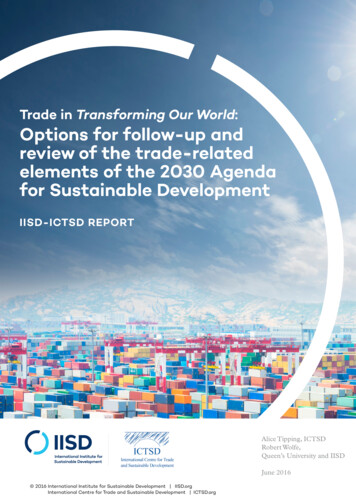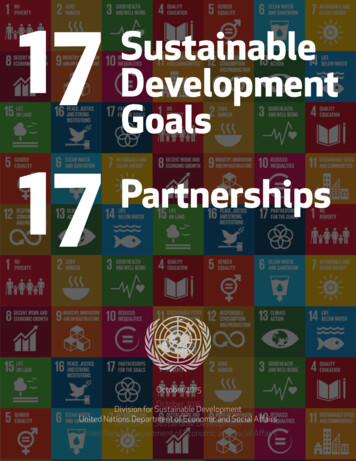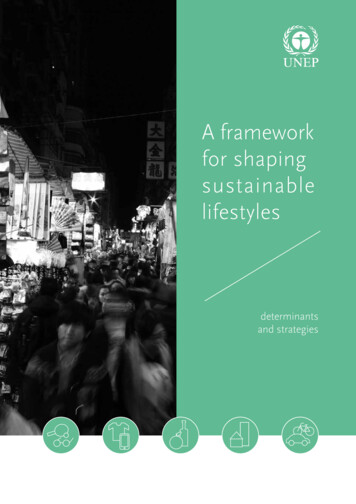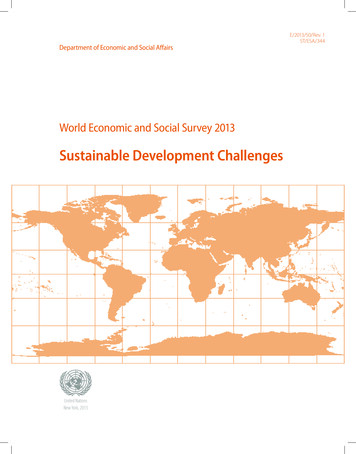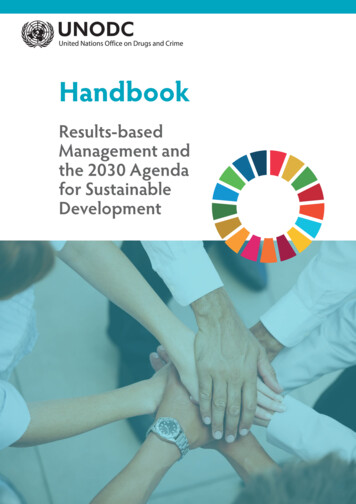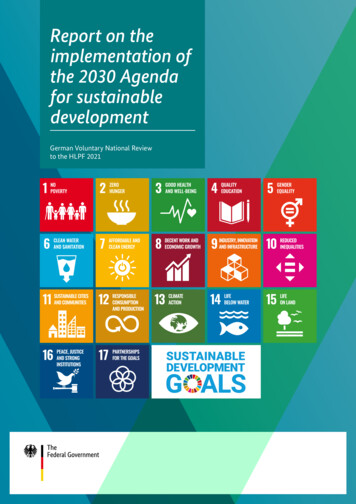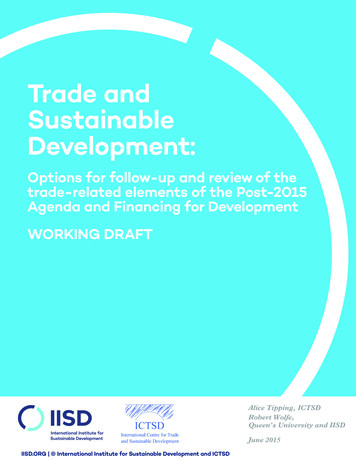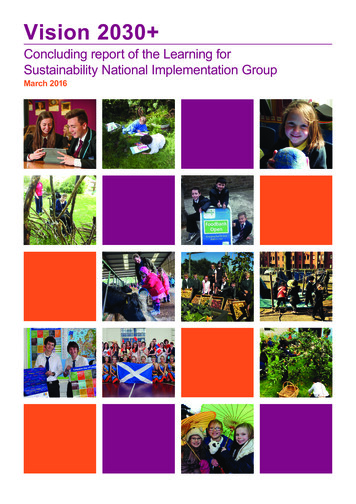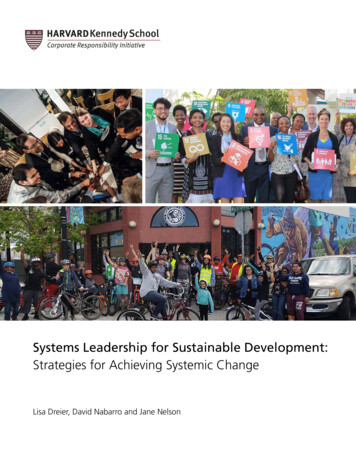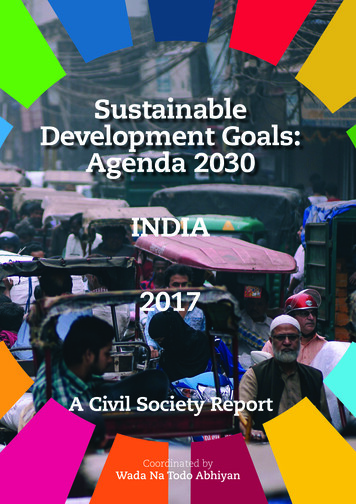
Transcription
SustainableDevelopment Goals:Agenda 2030INDIA2017A Civil Society ReportCoordinated byWada Na Todo AbhiyanCivil Society Report onSustainable Development Goals: Agenda 203001
ABOUT WADA NA TODO ABHIYANWada Na Todo Abhiyan (WNTA) is a national campaign focused on Governance Accountability to hold the government accountable for its promise to end Poverty, Social Exclusion &Discrimination.WNTA emerged from the consensus among human rightsactivists and social action groups who were part of the World Social Forum2004 (Mumbai). The purpose was to create an environment through focused andconcerted effort and try to make a difference in India where one-fourth of theworld’s poor live and experience intense deprivation fromopportunities to learn, live and work with dignity.In this regard, WNTA highlights the aspirations and concerns of the most marginalizedsections of the society – Dalits, Adivasis, Nomadic Tribes, Minorities, Women, Sexual Minorities, Children, Youth and the Person with disability to the government through People’sManifestoes before elections. Further, WNTA reviews and monitors the performance of thegovernment on its promises and plans towards the marginalized sections on the frameworkof Constitutional mandates, National development goals and International commitments setin the UN Millennium Declaration (2000) / The 2030 Agenda for Sustainable DevelopmentGoals.We work to ensure that the concerns and aspirations of the marginalized sections are mainstreamed across programs, policies and development goals of the central andstate governments.Contact:Wada Na Todo AbhiyanC-1/E, IInd Floor, Green Park EXt.New Delhi - 110016.Ph: 011-46082371Email: info.wadanatodo@gmail.com
2017SustainableDevelopment Goals:Agenda 2030A Civil Society ReportCoordinated byWada Na Todo Abhiyan
iiCivil Society Report onSustainable Development Goals: Agenda 2030
ContentsPrefacevExecutive SummaryviiGoal 1:End poverty in all its forms everywhereGoal 2:End hunger, achieve food security and improved nutrition and promote sustainableagriculture10Goal 3:Ensure healthy lives and promote well-being for all at all ages18Goal 4:Ensure inclusive and equitable quality education and promote lifelong learningopportunities for all30Goal 5:Achieve gender equality and empower all women and girls36Goal 6:Ensure availability and sustainable management of water and sanitation for all43Goal 10:Reduce inequality within and among countries52Goal 11:Make cities and human settlements inclusive, safe, resilient and sustainable61Goal 13:Take urgent action to combat climate change and its impacts69Goal 16:Promote peaceful and inclusive societies for sustainable development, provideaccess to justice for all and build effective, accountable and inclusive institutions atall levels78Annexure IMigrants (Construction Workers)88Annexure IIPerson With Disability96Annexure IIIDenotified Tribes (DNTs)1101Civil Society Report onSustainable Development Goals: Agenda 2030iii
Coordinators : Abdul Rauf, Dr. Deepak Nikarthil, Radhika Mathur and John Animesh GomesPrinted on : 6th July 2017Design : Aspire DesignivCivil Society Report onSustainable Development Goals: Agenda 2030
PrefaceAll UN member states are committed to achieve SDGs Agenda 2030 consisting of 17 goals and 169 targets, spanning the three dimensions of economic, social and environmental development. Under this framework, eachnational government as well as other stakeholders, including local governments, business and the civil societyis expected to identify, implement and report on specific actions that lead to their achievement. The nationalgovernment has to translate these goals and targets into the national policies, to resource and implement thesepolicies and to measure their implementation. On the other hand, civil society organisations are expected toplay an important role in popularizing SDGs as well as take on role for monitoring the implementation of theSDGs.In a diverse country like India, it becomes necessary to first review the systems that are in place for ensuringthe participation from all stakeholders- from people in the grassroots up to the highest levels of Government.Since the Government is the biggest entity with the most resources to ensure achievement of the SustainableDevelopment Goals (SDG) and targets that have been set, the legal and policy framework already in place in thecountry has to be critically reviewed to see how capable it is of achieving the SDGs and identify the gaps andchallenges for rectification. The UN resolution also mentions that the business sector, non-state actors and individuals too must play a significant role in ensuring the achievement of the SDGs. Therefore, the existing effortsby these other sectors and individuals also have to be reviewed for proper planning.A year has gone by and there has been a lot of progress done on SDGs by Government of India, NITI Aayog andcivil society organizations in popularizing SDGs at national and sub national level. NITI Aayog has drafted National Indicators and a compendium of recommendation on the indicator has been submitted by the civil soci-ety organization on April 7th, 2017. WNTA as a platform of various civil society organisations in partnership withoffice of United Nations Resident Coordinator (UNRC) have actively engaged with the Ministry of Statistic andProgramme Implementation (MoSPI) and NITI Aayog in advocating the national indicators from the perspectiveof the most marginalized section of the society. WNTA organized the national multi-stakeholders’ consultationon SDGs to strategise a common accountability framework for Civil Society on 8th& 9th November 2016 from theprism of the most marginalized communities to achieve the agenda of ‘Leave No one Behind’.The Government of India is presenting its Voluntary National Review report on SDGs at High-Level Political Forum (HLPF) on Sustainable Development 2017 in New York. The government has formed a taskforce with differ-ent concerned ministries and agencies to prepare the report. NITI Aayog is the nodal agency coordinating thisprocess.The Civil Society, anchored by WNTA, in partnership with the different members of the Civil Society had a planning meeting to strategize the process of the Civil Society Report on the SDGs and a detailed discussion on thestrategy, methodology and time line on 21st March 2017 at Indian Social Institute, New Delhi, followed by meetings on 5th May 2017 and 19th June 2017 at National Foundation for India (NFI), India Habitat Centre.Different groups consisting of different civil society organizations, campaigns and networks were formed aroundten goals of the Agenda 2030. A compendium of ten goals was collected from all the groups and a final reportwas prepared, which would be further shared with wider civil society groups and different stakeholders at thenational level. The Civil Society report on SDGs was prepared by a large number of Civil society organisationsand networks through desk research and consultations with local communities, particularly, the marginalizedcommunities. The report has used the lens of ‘Leave No one Behind’ and ‘A Life of Dignity for All’ as proposedby the SDG framework.The aim of this Civil Society Report on SDGs would be to highlight the status of SDGs in India with the UN andother International agencies and to create traction on SDGs: Agenda 2030 involving multi-stakeholders andevolve a common civil society Accountability Framework from the prism of social exclusion for monitoring andCivil Society Report onSustainable Development Goals: Agenda 2030v
consensus building on the status of the SDGs in India. The Report also envisages to map the existing government inter-ventions at national, state and local levels as well as to identify the gaps and challenges to achieve the SDGs in order toactively engage with the Indian state and create a platform for dialogue between the Civil Society and the Governmenton SDGs.The recommendations and suggestions emerging from the Civil Society Report on SDGs will further be advocated withthe Government of India, parliamentarians, thematic experts, government think tanks, other government departmentsand stakeholders. Moreover, WNTA will be releasing the Civil Society Report on SDGs at a national level event in NewDelhi on 6th July 2017 as well as at the side event during HLPF in New York on 11th July 2017.Amitabh Behar, Annie Namala, Awadh Kishore Singh, Paul Divakar and Thomas PallithanamConvenors,Wada Na Todo AbhiyanviCivil Society Report onSustainable Development Goals: Agenda 2030
Executive SummaryThe 17 Goals of the 2030 Agenda for Sustainable Development — adopted by 193 nations in September 2015 at the UNSummit — officially came into force on 1 January 2016. While ambitious and universal in nature, they have, in principle, charted out a path for nations to achieve development that is fair, equitable, inclusive and environment friendly.Human and environmental rights underpin the foundation of the SDGs that demand robust and integrated actionsnationally, recognizing the role of different actors in the process.The SDGs being interdependent in nature, require actions at all levels to attain the development outcomes. In the Global South context, it is only logical to deduce that much is desired of the emerging economies of the world (BRICSAMnations), which account for highest proportion of poorest communities. And with the rising Gross Domestic Product(GDP), India accounts for the largest number of people living below international poverty line, with 30 per cent (nearly800 million) of its population living under 1.90 a day (World Bank, 2013).Poverty is more than lack of income or resources- it includes social discrimination and exclusion, lack of basic services,such as education, health, water and sanitation, and lack of participation in decision making. These ‘durable inequalities’ perpetuate acute poverty, limiting the life options of historically marginalised communities. The recent CreditSuisse report shows that the richest 1 per cent Indians now own 58.4 per cent of the country’s wealth. In a countrywhere more than half the households are dependent on land (agriculture had 48.9 per cent of employment share in2011-12), its distribution is highly unequal. The visible fiscal and economic inequalities are undercut by gross socialinequalities based on identity and social status, viz. caste, ethnicity, religion, region, age and gender.National and state-level statistics testify to the trends of exclusion from land ownership and agriculture. Census datareveals that in the 10-year period between Census 2001 and Census 2011, there were nearly 9 million less cultivatorsin India. The number of landless agricultural workers in the country rose from 106.7 million in 2001 to 144.3 million in2011. Further, landlessness is highest among Dalits (57.3 per cent), Muslims (52.6 per cent) and women headed (56.8per cent) households, castigating them to work as agricultural labourers, and to face the specter of depressed andunequal wages or to be expelled altogether to join the massive migration to the cities. Constituting only 8 per cent ofthe population, the Tribals shouldered 55per cent of the development induced displacement till 1995, and not muchhas bucked the trend to date. There is also a growing trend of feminization of agricultural labour, but only 13.6 per centhouseholds are headed by women, owning 7.17 per cent of total productive land. Even where they report ownership ofproductive land there is the question of who controls the use of such land.Besides, in India, employment generation is abysmally low even during the periods of high growth rate. The youthpopulation, is therefore, either getting into unskilled /informal labour sector where scope for economic bettermentis too narrow.The decline in agricultural investments that started in the 1980s is continuing till date. A total of 12, 602 farmer suicides were reported officially, with Maharashtra topping the list with 4,291 suicides, followed by Karnataka 1,569, Telangana 1,400, Madhya Pradesh 1,290, Chhattisgarh 954, Andhra Pradesh 916 and Tamil Nadu 606 farmer suicides. Togeth-er, these seven states accounted for 87.5% (11,026) of total 12,602 suicides in the farming sector in the country. The percapita availability of land has declined from 0.5 hectares in 1951 to 0.15 hectares in 2011, with shrunken agriculture, andrelated insecurities due to commercialization, natural disasters and climate vagaries.India released the first National Disaster Management Plan (NDMP) in June 2016. While the Indian Government hasembarked upon building urban infrastructure across the country and develop 100 smart cities over the coming years,it is important for cities and infrastructure being built to consider the topography of the area and its vulnerability tovarious hazards.One of the fundamental problems is the lack of appropriate vulnerability assessment mechanism. Most of the stateplans are based on the Vulnerability Atlas of India. While this provide macro level analysis, it leaves out the slow onsetdisasters such as droughts and sea level rise. In 2016, 255,923 villages across 10 states suffered severe drought, whichimpacted food security and access to water, resulting in acute indebtedness. And despite the known vulnerability ofIndia to various disasters, most of the mitigation programmes so far are designed as responsive/ reactive, and notresilience centric.Civil Society Report onSustainable Development Goals: Agenda 2030vii
Appropriate infrastructure for India Meteorological Department (IMD), rainfall and weather monitoring stations, lackof forecasts providing information down to the village level rather than giving it for regions, and lack of IMD andISRO information in a user-friendly and understandable manner remains the need of the states. Issues like migration,indebtedness, and livelihood regeneration are yet to be considered as a part of climate change and DRR planning inthe government policies; which will make the approach to sustainable cities and communities comprehensive and riskresilience focused (SDG 11).As far as the local governments are concerned, they have almost no role in managing climate change and disasters.The 73rd and 74th Constitutional Amendment Act, 1992, which aimed at empowering local rural and urban authoritiesincluding the right to raise resources, pursue social justice policies and contribute to economic development, largelyremains unimplemented. This is ironical as world over these are local governments who are leading the transition ofcities.Lack of jobs in rural areas and low returns on agriculture have only created a pool of seasonal migrants flowing intourban centers, settling down in slums working in casual/unorganized sector or being rendered homeless. The Government is implementing its National Rural Drinking Water Programme through the concerned ministries for ensuringdrinking water to people in the rural and urban areas. There are several programmes run by the Government aroundriver development and rejuvenation of Ganga River in India. Despite all this, there are still 76 million people who do nothave access to safe drinking water in India today.Absorption into the un organised sector fueled rather by distress than by choice hides huge underemployment. In asituation where even the formal sector is being in formalised in the form of contract labour, the working conditionsrange from insecure to precarious to near or total bondage, impacting health and wellbeing of the workers adversely.As it stands now, government spending on health is around 30 per cent of the total expenditure on health in India, while62.4 per cent of the total expenditure is borne out of pocket. In such a scenario, wage labourers sometimes prefer pri-vate health services to save a day’s wage being lost to long waits in the government hospitals. This demonstrates thepoor quality of healthcare in India and the disproportionate burden that it imposes on the poor and the marginalised.India does not yet explicitly recognise a national minimum social security cover.In the 2017-2018 Union Budget, the Finance Minister announced an allocation of Rs. 48,000 crores to the MahatmaGandhi National Rural Employment Guarantee Scheme (MGNREGS), which is the highest allocation to the schemeever. But this is only a 1 per cent increase from the Rs. 47,499 crores (revised estimate or RE) in 2016-17. Furthermore,expenditure for 2016-17 (as on 1 February) is Rs. 53,594 crores which indicates a massive shortfall. The absence or poorquality of social security provisions, both in coverage and quantum, has further intensified the impoverishment of thepoor in India. Government records show that under the MGNREGS, Rs. 441 crore worth of compensation was due to theworkers against delayed wages in financial year 2016-17.Health spending by the Central government remains at only 0.3 per cent of the GDP out of a total 1.3 per cent of GDPspent by the states and Centre together. In fact, the total spending is a far cry from the 3 per cent of GDP which iswidely accepted to be the minimum level required to achieve reasonable universal health coverage.As per the data of Rapid Survey on Children (RSOC) of the Ministry of Women and Child Development, about 44 %of the adolescent girls could be classified as severely thin. This prevalence increases further when we look at sociallyexcluded groups like Scheduled Caste (SC) (46.4%) and Scheduled Tribes (ST) (45%); with highest number of severelythin adolescent girls amongst the lowest income quartile (47.9 %). The states with high rates of stunting include Chhat-tisgarh, Madhya Pradesh, Bihar, Jharkhand, Assam, Gujarat and Meghalaya. Bihar tops the list with 49.4 % of children inage group of 0-59 months stunted.The number of women in the reproductive age group of 15-49 years with lower than normal Body Mass Index (BMI)reduced from 35 % in 2005-06 to 22.9 % in 2015-16 as recorded in the last two rounds of National Sample Survey Office(NSSO). Almost 52 % of women in rural areas were as anemic as 45.7 % women reported anemic in urban areas.The National Health Policy 2017 talks of “strategic purchasing”, which indicates a push towards privatisation. Trackingprogress towards the SDG 3 targets will require a robust and reliable monitoring system, as well as a strong accountability mechanism, both of which are currently lacking.viiiCivil Society Report onSustainable Development Goals: Agenda 2030
Close attention needs to be paid to inequities in health indicators as well as provision of services, especially along linesof caste, class, religion and geographical location, and specific concerns of marginalized groups especially Dalits, Tribals, religious minorities and women must be taken into account in the designing and provisioning of health services.To attain Goal 4 on the quality education, India will have to increase its spending to 6 % of the GDP on education ascompared to the current 3.5% spending. The government, in the previous three years, has made impressive strides withits national campaign of Swachh Bharat, and according to the ASER 2016, there has been improvement in the number ofschools with toilets but, even now nearly 200,000 are running without toilets. These conditions push children, especial-ly girls to drop out, besides bringing children at risk of illnesses that can be avoided if provided for Water, Sanitationand Hygiene requirements. The Union Budget has ignored effective implementation of the Right to Education, and ameagre increase in the Sarva Shiksha Abhiyan’s budget – by Rs 1,000 crores – is far from helping the meaningful implementation of the Act and achievement of SDG 4.The progress of the community is measured by the degree of progress which women have achieved. India ranks 88thoutof 186 countries in the list on number of women parliamentarians with 18.5 per cent of women appointed in ministerialpositions as of January 1, 2017 (United Nations, March 16, 2017). There are only five ministers (18.5 %) in the Cabinet,and only 8 states having more than 10% of women members in the Legislative Assemblies; 12% of parliamentariansconstitute only 12%.The Lok Sabha and Rajya Sabha have only 11.8 % and 11 % representation of women, respectively.Reservation of 33% for women in the government has improved representation of women in urban and rural areas, buttheir voice and participation remain tethered. In the armed forces, women only constitute 5.4 %. However, induction ofwomen fighter pilots is a positive step towards gender equality. The 68th Round of National Sample Survey (2011-12) por-trays that the labour force participation rate of women in India, dropped from 42.7 % in 2004-05 to 31.2% in 2011-12. TheGlobal Wage Gap Report (2016) informs that the proportion of women in India represent no more than 10–15 per cent ofwage earners. World Economic Forum (2016) reports that only less than 9% of the firms have female representation inthe top management. Only 58.75% of females are literate as compared to 62.31% among the males. The figures for SCand ST women are 56.5% and 49.4% respectively. Overall, Muslim women’s participation in employment is significantlylow. State response to poor outcomes for religious minorities has been one of either complete denial or of lip service.India recorded 644 incidents of communal violence in 2016, compared to 751 in 2015, and 703 recorded in 2014. Thenumber of larger incidents may have come down, but there are many small incidents as low-intensity violence andpolarisation along communal lines is increasing. Similarly, the NCRB lists 45,003 cases of atrocities against SCs and10,914 against STs with a conviction rate of 27.6 in both the cases in 2015. Although better reporting is a reason forhigher numbers in the recent years, the low rate of conviction is a dampener in this struggle to access justice. This willbe a major threat to the attainment of peace and justice (SDG 16) for India if not contained through preventive actions.The National Crime Records Bureau (NCRB) recorded 3, 27, 394 crimes (a slight decrease of 3.1 % from 2014) with arise in crimes on molestation, the Immoral Traffic (Prevention) Act, abetment of suicide of women, rape and domesticviolence in 2015. Specifically, 8000 crimes against Dalit women were reported at the rate of a crime per hour. The con-viction rate remained low at 21.7 %, with 10,80,144 cases pending disposal. These trends must be rigorously altered tostay true to the SDG 5.The LGBT Community remains most discriminated and excluded from public services and society. Section 377 of theIndian Penal Code continues to criminalise sexual minorities. Their basic existence to live a fearless life is under bigthreat. Government’s refusal to vote in the United Nations Human Rights Commission’s (UNHRC) resolution to setup the office of an independent expert to end discrimination against LGBTQ people shows their stand on the LGBTQrights.Gender inequalities have curbed progress of women in India, while caste has played an important role in exclusion ofa community which consist of more than 201 million people in the country. Religious minorities, differently abled andpeople with different sexual orientation have faced similar discrimination in their socio-economic and political aspectsof life. The inter sectionality of these social groups has seen the further exclusion and inequalities to another spectrum.The elderly population of age 60 and above is another marginalised and silenced group which is fast growing in India.Their population jumped 35.5 per cent — from 7.6 crores in 2001 to 10.3 crores in 2015. The Elder Abuse study by HelpAgeIndia (2014) revealed1 in 3 older people reported abuse within the family ranging from physical abuse to verbal abuseMoreover, according to the Crime in India 2014 report by the NCRB, there is a significant increase in crime against olderpeople who are considered soft targets.Civil Society Report onSustainable Development Goals: Agenda 2030ix
The SDGs cannot accrue benefits to these communities with a conventional headcount approach to poverty. The indicators, therefore, need to adopt a holistic approach, which evaluates access of marginalised and vulnerable commu-nities to quality basic services, and dis aggregates data to assess progress made regarding all dimensions of poverty.There is a need to ensure that public policies that contribute towards achieving SDGs are governed by the principles ofintersectionality that can be measured by predetermined indices. Hence, reducing inequalities within the country andcommunities (SDG 10), points categorically towards socio-economic and political equity and erasing of any discriminatory mechanisms which propels inequality among the people which the Government of India must work hard upon.The Government must ensure engagement and influence of people’s representatives in planning and implementationfor realization of SDGs by instituting oversight function for Parliamentarians in the enactment of legislation and adoption of budgets, as envisioned by the SDG General Assembly Resolution.xCivil Society Report onSustainable Development Goals: Agenda 2030
SDG 1End poverty in all its formseverywhereGoal 1 calls for an end to poverty in all its manifestations by 2030. It also aims to ensure social protection for the poorand vulnerable, increased access to basic services and support people harmed by climate-related extreme events andother economic, social and environmental shocks and disasters.TARGETS1.1 By 2030, eradicate extreme poverty for all people everywhere, currentlymeasured as people living on less than 1.25 a dayThe main message of India’s Voluntary National Review on implementation of the SDGs submitted by the Governmentof India says, “(r)apid growth (SDG 8) is the key weapon in any country’s arsenal for combating poverty”,1and goes on toextoll the rapid growth in India, measured at 7.9 in 2015, and 7.1 in 2016.The fact is that extreme poverty in India is historic continuously worsened by additional processes of impoverishmentthat build on these historic exclusions of gender, caste ethnicity and religion that the growth orthodoxy either aidsor abets or chooses to ignore, resulting in unparalleled inequalities. The recent Credit Suisse report shows that therichest 1 per cent Indians now own 58.4 per cent of the country’s wealth.2 Resource distribution is highly unequal in allareas and more fundamentally on the question of land.In a country where more than half the households are dependent on land (agriculture had 48.9 per cent of employmentshare in 2011-12), its distribution is highly unequal. 41.86 per cent of rural households do not own any productive landand about 7.94 per cent households do not even have their own homestead land according to the NSSO report, 2014.Further, landlessness is highest among Dalits (57.3 per cent), Muslims (52.6 per cent) and women headed (56.8 percent) households, castigating them to work as agricultural labourers, and to face the specter of depressed and unequalwages orto be expelled altogether to join the massive migration to the cities.3 Swelling their ranks are the tribal forwhom dispossession has come with development; constituting only 8 per cent of the population, they have shouldered55per cent of the development induced displacement till 19954, and not much has bucked the trend to date.The shift out of agriculture may have been celebrated in certain quarters, but the absorption into the unorganisedsector is fueled by distress rather than choice, and hides huge underemployment. In a situation where even the formalsector is being informalised as contract labour5, the working conditions range from insecure to precarious to near ortotal bondage.In India, when employment generation is abysmally low even during the periods of high growth rate6, Skill India couldbe one of the answers. Though the annual target of 2 million in 2014-2015 was partially achieved with 1.3 million covered123456Voluntary National Review on implementation of the SDG goals, 2017Source: Credit Suisse Research Institute, Global Wealth Report 2016Chachra, Sandeep et al, “Exclusion and Expulsion in Agriculture” in India Exclusion Report 2016, Yoda Press, New DelhiFernandes, W. “Development-Induced Displacement: The Class and Gender Perspective”, November, rativeMinistry/NESRC/Walter.htmlIndia Labour Market Update ILO Country Office for India July 2016The National Sample Survey Office (NSSO) data on employment in 2011 shows how from 2004-05 and 2009-10, only 1 million jobs were addedper year, in a period when the economy averaged a record 8.43% growth annually. In this period, 55 million people joined the labour force (LiveMint, 2016).Civil Society Report onSustainable Development Goals: Agenda 20301
under the PMKVY, it has spent Rs.1500 crores to train 18 lakh persons7 but only 12 per cent of those trained have beenplaced so far.The larger questions, however, are the investment required for each job created in the industrial sector and the eco-logical limits to industry led growth. The carrying capacity of the earth has already been crossed in many ways and theGoals, which are named “sustainable”, cannot ignore these.What then is the answer? It is recommended that revival of agriculture should be prioritized through the restructuringof rural economy with focus on progressive land reforms and on women’s ownership. The decline in agricultural invest-ments, which started in the 1980s and is continuing till date,8 must be reversed. Adequate credit and supportive farmprices promoting sustainable farm practices with special emphasis on water conservation and availability must beundertaken on the largest scale possible.The Mahatma Gandhi National Rural Employment Guarantee Scheme (MGNREGS) has been
Wada Na Todo Abhiyan. Civil Society Report on Sustainable Development Goals: Agenda 2030 vii Executive Summary The 17 Goals of the 2030 Agenda for Sustainable Development — adopted by 193 nations in September 2015 at the UN Summit — officially came into force on 1 January 2016. While ambitious and universal in nature, they have, in princi .
